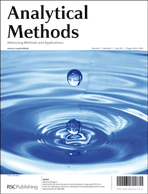A simple method was developed for spectrophotometric determination of some nonsteroidal anti-inflammatory drugs (meloxicam, piroxicam and tenoxicam) based on the reduction of copper(II) in buffered solution (pH 7.0) and micellar medium containing 4,4′-dicarboxy-2,2′-biquinoline acid. The absorbance values at 558 nm, characteristic of the formed Cu(I)/4,4′-dicarboxy-2,2′-biquinoline complexes, are linear with the concentrations (5.7–40 μmol L−1, n = 5) of these oxicams (meloxicam r = 0.998; piroxicam and tenoxicam r = 0.999). The limit of detection values, in μmol L−1, calculated for meloxicam (2.7), piroxicam (1.2) and tenoxicam (1.3) was obtained with 99% confidence level and the relative standard deviations for meloxicam (3.1%), piroxicam (5.1%) and tenoxicam (1.2%) were calculated using a 25 μmol L−1 solution (n = 7). Mean recovery values for meloxicam, piroxicam and tenoxicam forms were 100 ± 6.9, 98.6 ± 3.6 and 99.4 ± 2.5%, respectively. The conditional potential of Cu(II)/Cu(I) in complex medium of 7.5 mmol L−1 BCA was determined to be 629 ± 11 mV vs. NHE.

You have access to this article
 Please wait while we load your content...
Something went wrong. Try again?
Please wait while we load your content...
Something went wrong. Try again?


 Please wait while we load your content...
Please wait while we load your content...